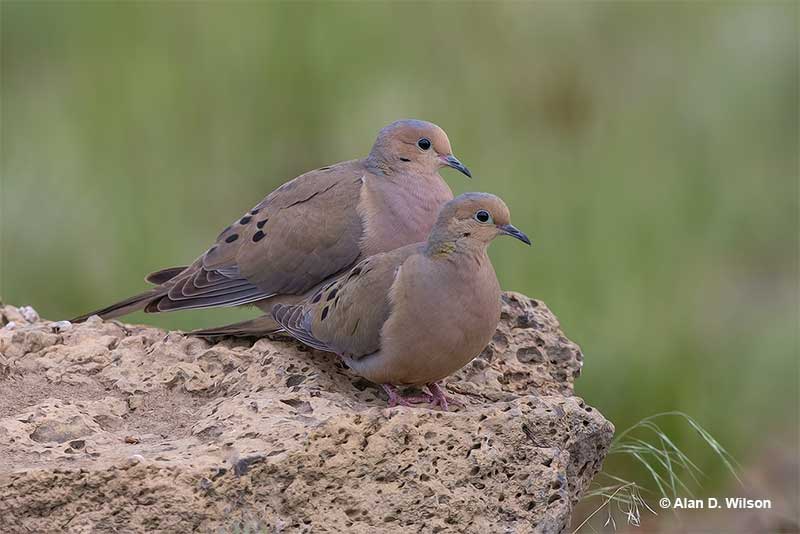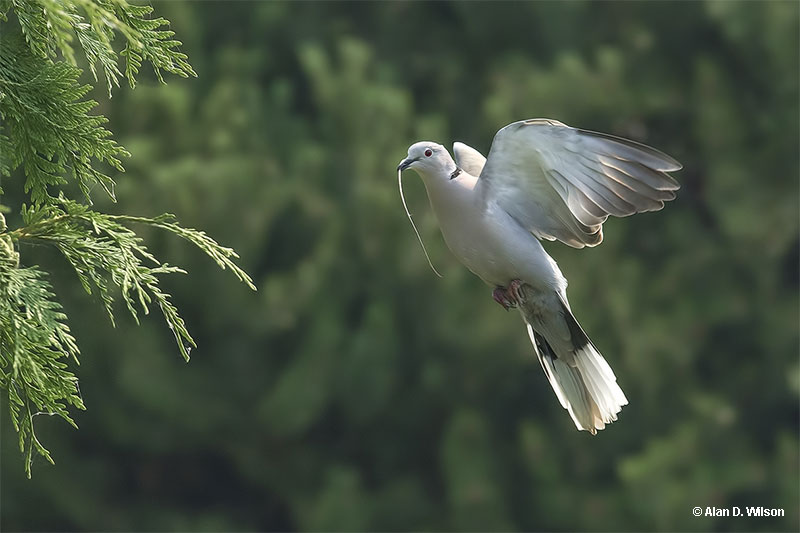
Doves are peaceful and lovely birds to watch! Easy to see, these familiar birds also come to feeders and grace the backyard with mournful, relaxing calls.
If you have a tall tree in your yard, a pair of doves might also nest in it!
But do doves mate for life? See this article to learn all about the mating behavior of doves!
On this page
The Bonds Between Doves
Doves form strong pair bonds. In fact, most dove species mate for life! However, one of the exceptions to that rule is the most common dove in North America, the familiar Mourning Dove. This species forms a strong pair bond for one nesting season but may or may not mate with the same bird the following year.
Related: What do doves symbolize?
This behavior is probably related to the fact that this species doesn’t live as long as other doves.
Since Mourning Doves have an average lifespan of just a year or two, they might pick another mate simply because the first one had died.
They might also pick another mate because their short lifespan simply means that they can’t wait around to find a mate and make a nest. They are in a hurry to nest and can raise five or six broods in a year!
Other dove species that live longer are monogamous and are known to mate for life. These include the Rock Pigeon, Eurasian Collared-Dove, and other species. All of these birds form strong pair bonds that last for several nesting seasons, and generally until one of the bird dies.
Such strong pair bonds help doves raise several broods of healthy young birds.
How do doves find their mates?
Doves find their mates like most birds do; with a good courtship display. In the case of doves, that translates to a nice song and dance.
Although they don’t make melodious vocalizations like other birds, doves actually do sing. Their cooing and mournful, owl-like sounds are their songs. Similar to many other birds, Mourning Doves and other dove species also sing from a high perch.

This helps their voice carry further and increases the chances of being seen by a female dove. They also sing as loud as they can because female birds tend to recognize that as a sign of a healthy and suitable mate. Doves are no exception and males do their best to show how fit they are with a deep and far-carrying voice.
After singing, male doves also fly into the air, make clapping sounds with their wings, and then glide back down to their perch.
If a male dove manages to attract a female, he continues to vocalize while moving back and forth in front of the female. He also puffs his neck feathers to highlight their iridescent colors, opens and closes his wings, and raises and spreads his tail.
He keeps making those moves until the female accepts him to be her mate.
The Father’s Role
One of the main reasons why doves form monogamous and lifelong pairs is probably because the male doves help with nesting duties. The male starts the process by picking the nesting site.
In the case of the Mourning Dove, the male finds a sturdy branch, ledge, or an old Mourning Dove nest. After picking a good spot, he calls to the female and flicks his wings. If she accepts the nest site, she sits on it, and the male brings her twigs and other nesting materials.

He perches on the female’s back, gives her the twigs, and she arranges them to make the nest!
Once the nest is ready, she lays two eggs, and both parents incubate them for around two weeks. During that time, the father dove sits on the eggs each day, from the middle of the morning to the later afternoon.
After the nestlings hatch, he helps brood them each day. He also helps feed the nestlings just as much as the female, including giving them “crop milk”, an energy rich substance adult doves make in their crops.
When the young birds fledge, their father accompanies them to roosting areas for the first few nights. He also helps feed them for one or two more weeks.
The Bonds of Doves – Fun Facts
- During the breeding season, paired doves often show affection by preening each other.
- Like most birds, the male makes a courtship display, but the female decides which male to choose for a mate.
- Mourning Doves can build a nest in trees, shrubs, on ledges, cacti, or even on the ground!
- The nests of Mourning Doves and other dove species are small and flimsy structures.
- In desert regions, doves keep their eggs cool by touching the eggs so that excess heat is transferred to themselves. They then pant to dissipate that heat.
- For some species, male and female doves look pretty similar to each other. However, in most dove species, males are just a bit more brightly colored than browner females.
- Many dove species also have contrasting black and white markings on their tails and wings. They use these markings in their courtship displays.
- During the breeding season, male doves often chase each other, with the female following close behind.
Frequently Asked Questions
Do doves stay with the same partner?
Yes, doves stay with the same partner. However, Mourning Doves can change partners from one breeding season to the next.
Do doves stay together after mating?
Yes, many doves stay together after mating. Mourning Doves form flocks after nesting and may or may not stay with their mate.
Do both male and female doves sit on the nest?
Yes, both male and female doves sit on the nest.
Do male doves feed their babies?
Yes, male doves feed their babies.
What is the lifespan of a dove?
The lifespan of a dove is just one to three years. Rarely, some Mourning Doves can live much longer, even for 30 years.

